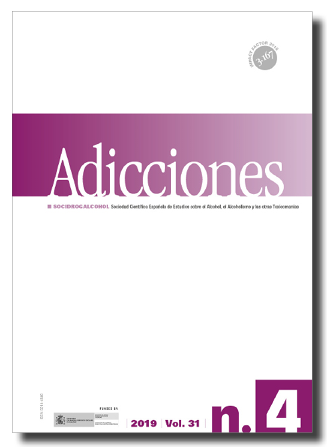What to do when drivers test positive for methadone in roadside drug tests? The Spanish Experience
DOI:
https://doi.org/10.20882/adicciones.1249Keywords:
methadone, opioids, roadside drug tests, medication, patient's.Abstract
Driving under the influence of illicit drugs, as well as some legal substances, is against the law internationally (WHO, 2016). To prevent such risky behaviour, Spain is one of the European Union countries with a zero tolerance policy, where driving with any amount of drugs in the body is illegal. Roadside drug screening or testing is mandatory (the law penalises all those who refuse to undergo such tests believing they would turn out positive), and are performed on oral fluid. When a driver tests positive, a second sample of oral fluid is obtained and sent to accredited laboratories for confirmation and quantification analysis of the detected substances.References
Álvarez, F.J., González-Luque, J.C. y Seguí-Gómez, M. (2015). Drugs, Substance Use Disorder and Driving: Intervention of Health Professionals in the Treatment of Addictions. Adicciones 27, 161–167. doi:10.20882/adicciones.702.
EMCDDA. (2017). European Drug Report 2017. Lisbon: EMCDDA. Recuperado de http://www.emcdda.europa.eu/edr2017.
Fierro, I., Colás, M., González-Luque, J.C. y Álvarez, F.J. (2017). Roadside opioid testing of drivers using oral fluid: the case of a country with a zero tolerance law, Spain. Substance Abuse Treatment, Prevention, and Policy, 12, 22. doi:10.1186/s13011-017-0108-3.
Guardia, J. (2018). Overdose epidemic linked to the prescription of opioid analgesics in the United States. Adicciones, 30, 87-92. doi:10.20882/adicciones.936.
Gutierrez-Abejón, E., Herrera-Gómez, F., Criado-Espegel, P. y Álvarez, F.J. (2017). Use of driving-impairing medicines by the population: a population-based registry study. BMJ Open, 7, e017618. doi:10.1136/bmjopen-2017-017618.
Herrera-Gómez, F., García-Mingo, M., Colás, M., González-Luque, J.C. y Álvarez FJ. (2018). Opioids in oral fluid of Spanish drivers. Drug and Alcohol Dependence, 187, 35-39. doi:10.1016/j.drugalcdep.2018.02.016.
Plan Nacional sobre Drogas. (2018). Memoria 2016. Delegación del Gobierno para el Plan Nacional sobre Drogas (DGPNSD). Madrid: Ministerio de Sanidad, Servicios Sociales e Igualdad. Recuperado de http://www.pnsd.mscbs.gob.es/profesionales/publicaciones/catalogo/catalogoPNSD/publicaciones/pdf/2018_MEMORIA_2016.pdf.
Ravera, S., Monteiro, S., de Gier J. J., van der Linden, T., Gómez-Talegón, T. y Álvarez, F. J., the DRUID Project WP4 Partner (2012). A European approach to categorising medicines for fitness to drive: Outcomes of the DRUID project. British Journal of Clinical Pharmacology, 74, 920-931. doi:10.1111/j.1365-2125.2012.04279.x.
Volkow, N.D. y McLellan, A.T. (2016). Opioid abuse in chronic pain—misconceptions and mitigation strategies. The New England Journal of Medicine, 374, 1253–1263. doi:10.1056/NEJMra150777.
WHO. (2016). Drug use and road safety: a policy brief. Geneva: World Health Organization. Recuperado de http://www.who.int/iris/handle/10665/249533.








